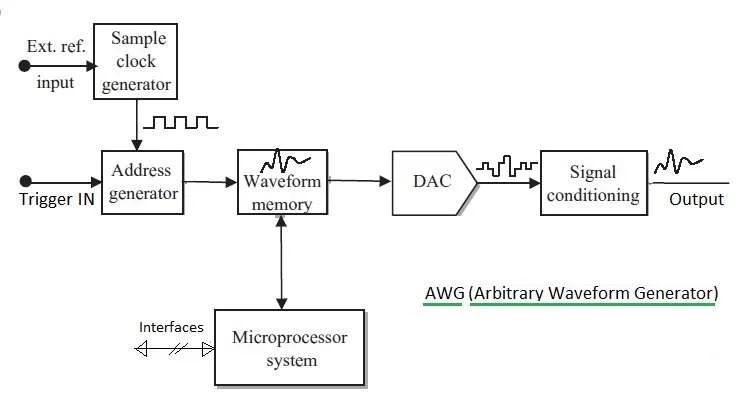AWG-Arbitrary Waveform Generator Basics
This article describes AWG (Arbitrary Waveform Generator) basics, AWG types (namely traditional AWG, DDS based AWG) and comparison of AWG with conventional waveform generators.
As we know AWG is used to generate vector signal waveform based on user defined waveform file. The desired file can be written or loaded in the memory. Now-a-days AWG module is used as part of Vector Signal Generator(VSG). Refer
This modules are used for wide variety of applications based on IEEE or 3GPP standards such as
WLAN, WiMAX, radar, GSM, LTE etc.
The AWG as part of RF VSG is used to generate baseband waveforms as per above mentioned standards.
This RF generated vector can be used to test receiver part of complex devices as per above mentioned standards.
PXI system used for T&M applications➤➤
and
RF VSG vs VSA➤➤

As shown in the figure-1, in standard AWG, user stored waveform samples from memory are clocks
and transfered to DAC. This analog waveforms are passed to filter module to generate desired output waveform.
The waveform signal and its shape depend on following parameters:
• sampling rate
• size of memory representing the number of points (time samples)
• vertical resolution
• DAC characteristics
• signal conditioning blocks (amplitude control using attenuator and amplifier)
• filters etc.
Comparison between AWG Vs conventional waveform generators
Following table summarizes comparison between AWG and earlier used simple waveform generators.
| Conventional function generator | Arbitrary function generator (AFG or AWG) |
|---|---|
| Standard waveforms only | Any wave shape can be obtained |
| Design is predominantly analogue | Design is digital |
| Wave shape cannot be stored | Wave shape can be stored |
| Specifications are analogue based | Specifications are digital based |
| Wave shape adjustment under computer control is generally not possible | Wave shape adjustment under computer control is possible with variety of techniques |
Traditional AWG vs DDS based AWG types

Arbitrary waveform generators are used to create
baseband waveform signals.
They all use same clocks, DACs, memories and filters, etc.
There are two types of AWG as mentioned below:
• Traditional AWG
• DDS (direct digital synthesis) based AWG
A traditional AWG uses variable sample clock and segments of look up table.
The lookup table contains information which represents the output signal's amplitude.
Each location in the table represents one point in the waveform to be generated.
A DDS based AWG uses a fixed clock, phase increment register, phase accumulator and a latch.
The traditional AWG needs several LPFs (low pass filters) whereas DDS based AWG needs only one LPF.
Refer DDS basic concepts➤➤.
Test and Measurement Related Links
RF Vector Signal Generation and Analysis
Test and Measurement Signal Generator Companies
Test and Measurement Signal Analyzer Companies
Physical layer measurements
Production tests on RF and SoC devices
GSM measurements tutorial
RF measurements tutorial
Testing and certification facility providers
Comparison between R&S CMU200 versus Agilent 8960 wireless test equipments
